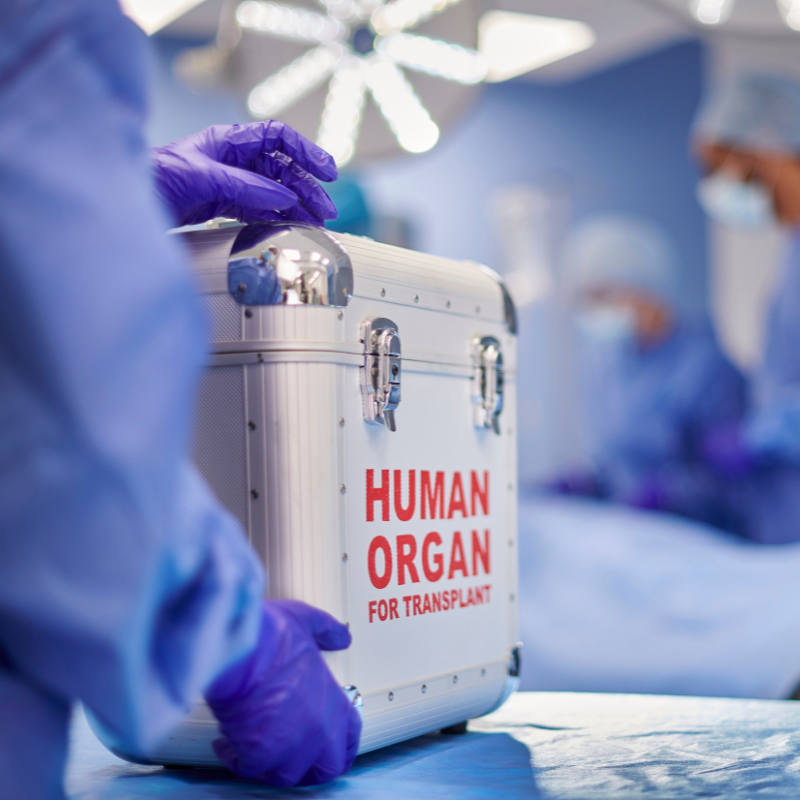What are the related health complications of ADPKD?
PKD can affect organs other than the kidneys. The following list of potential problems may look long and overwhelming, but it is important to remember that most people do not have all of these problems. If you have PKD, you and your family should be aware of the following possibilities so you can play an active role in understanding and managing your own healthcare.
Liver cysts
More than eighty percent of patients with PKD develop liver cysts during their lifetime. Liver cysts can occur in those under the age of 30, but are usually small and detectable only by MRI scanning. The liver can remain normal in size with a few cysts or can become enlarged. Even with increased liver size from PKD, the amount of functional liver tissue remains more than adequate. This means it is highly unlikely that patients with severe polycystic liver disease (PLD) would develop liver failure.
Although not common, severe PLD can present with symptoms due to a “mass effect” (i.e. abdominal fullness, pain, early satiety (feeling full), ankle swelling and fluid accumulation within the abdomen). In the severe and symptomatic cases, cyst decompression may be needed. When a few very large cysts are present, additional surgical intervention may be recommended to take care of these cysts. Partial liver resection may be considered in selected cases. This should only be performed at specialized centers with experienced surgeons.
Liver cysts occur more often in women than men. Women develop liver cysts at a younger age and have more and larger cysts than men. Women with previous pregnancies have more numerous and larger liver cysts than women without any pregnancies. This observation suggests that female hormones may influence the development of liver cysts. Because estrogen may be a factor in liver cyst growth, the benefits of estrogen replacement therapy (ERT) and the risk of PLD must be carefully weighed. A Nurses’ Health study has disproved any benefit of estrogen to prevent cardiovascular disease, however, estrogen replacement therapy is protective against osteoporosis and decreases vasomotor instability – a cause of hot flashes in postmenopausal women. Thus, the risk of estrogen for aggravating PLD against its potential benefits on post-menopausal symptoms and osteoporosis needs to be weighed. Work with all of your doctors (nephrologist, Ob/Gyn, and general practitioner) to determine what would be the best course for you.
Women with PKD who use estrogen after menopause should have a baseline ultrasound of their liver before they start ERT and every two years thereafter. This will help your doctor evaluate if liver cysts are increasing in number and/or size. It is unclear at this time if it is better to take ERT in pill form or by skin patch. Theoretically, the patch would be a better choice since oral therapy provides high concentrations of estrogen directly to the liver. Finally, there is no data looking at the effect of low-dose oral contraceptives on women with ADPKD. If you have significant PLD, you should discuss the use of these with your doctor.
One complication of PLD is liver cyst infection. Symptoms range from fever to pain in the upper right side of the abdomen. These symptoms need to be reported to your doctor as soon as possible. Treatments of an infected liver cyst usually require antibiotic therapy and occasionally needle drainage.
Mitral valve prolapse (MVP)
Mitral valve prolapse (MVP) is a condition where the valve separating the top and the bottom of the left side of the heart does not close properly. Sometimes this causes blood to leak back to the top part of the heart. This is called regurgitation and can be heard during an examination of the heart as a heart murmur. Symptoms that can be associated with MVP are palpitations, a feeling that the heart is running away or that there are extra beats in the heart and chest pain that is not associated with exercise or exertion. MVP occurs with increased frequency in patients with PKD as compared to the general population but rarely causes any significant clinical problems.
MVP is usually confirmed with an ultrasound of the heart valves called an echocardiogram. If MVP is present and causes palpitations that are bothersome, they can be treated with medications. Restricting the use of caffeine, alcohol, and
cigarettes may be enough to decrease or stop the palpitations in many cases.
Rarely, an infection of a heart valve can occur as a complication of MVP. Although not a common occurrence, it can lead to destruction of the heart valve. Therefore, if you have MVP and a heart murmur, inform all doctors who care for you.
Aneurysm
An aneurysm is an outpouching in a blood vessel, which can leak or rupture.
Intracranial (brain) aneurysms occur in the blood vessels of the brain. Symptoms can include sudden severe headache, pain in moving your neck, nausea/vomiting, difficulties with speech or movement and/or loss of consciousness. A ruptured aneurysm can be fatal. If you know you have an aneurysm (or have a family history of aneurysms) and you are experiencing any of these symptoms, you should call emergency services immediately.
Recent studies done in the United States have shown that PKD patients have about a 5 – 10 percent risk of developing intracranial aneurysms. This is about five times the risk of the general population. They also seem to cluster in certain families – that is, if a member of your family has an aneurysm or has ruptured an aneurysm, you may be at a higher risk of having an aneurysm yourself.
Because the risk for aneurysm is small, not everyone with PKD needs to be tested. However, people who have PKD and a family history of aneurysm should be tested, along with those whose job or hobbies would put them or others at risk if they lost consciousness (such as those who fly airplanes or drive buses). It is important to inform your doctor if you have a family history of intracranial aneurysms and/or if you have a high-risk occupation or hobby.
Aneurysms in other vessels such as the aorta have also been reported.
Magnetic resonance angiography (MRA) is the preferred test to screen for an aneurysm.
When an aneurysm is detected on an MRA, an arteriogram is usually performed. This test is more invasive and is done by putting dye directly into the blood vessels which will more clearly show if there is an aneurysm and how large it is.
If an aneurysm is found, surgical repair or a therapeutic coil (a device placed in the aneurysm by a neuroradiologist) may be recommended. If and when surgery is performed depends on the size and location of the aneurysm. Often an aneurysm can be repaired surgically before it leaks or ruptures. If you have had one aneurysm, you may develop others over time and need periodic follow-up. Recent studies suggest that patients with a positive family history of ICA should be screened with MRA every 5-10 years.
Hernias
Both inguinal and umbilical hernias are more common in those with PKD. Inguinal hernias are outpouchings in the area of the groin. Umbilical hernias are outpouchings at or near the navel. These should be surgically repaired if they are large or are causing problems, just as they would be in someone who does not have PKD.
Diverticulosis
Diverticula are outpouchings on the large intestine (colon). It appears that patients with PKD who are on dialysis or have had a transplant have diverticula more often and also have more complications from diverticula, including infection, than patients with other kidney diseases.
Diverticulitis can occur when diverticuli rupture or become infected, requiring treatment with antibiotics. This is a rare occurrence.
Diabetes
A recent study found that ADPKD patients face elevated risk of diabetes after a kidney transplant.
The Canadian Journal of Diabetes reports a detailed analysis of 12 studies, which comprised 1,379 patients with ADPKD of a total of 9,849 patients who had undergone kidney transplants and found that individuals with ADPKD who undergo a kidney transplant have a higher association of new-onset diabetes than non-ADPKD kidney transplant patients. These findings may impact disease management of ADPKD patients before transplant and follow up after transplant.
In a comment from SAC member Ronald Perrone, M.D. “In light of this study, the advice I have for patients is that maintaining a healthy diet and healthy weight both before and after transplant are key to avoiding an increased risk of type 2 diabetes”.
You can read a synopsis of this paper here.
Does ADPKD in children involve organs besides the kidney?
Just as in adults, children who have ADPKD are more likely to have mitral valve prolapse (MVP) and hernias than children who do not have ADPKD. Approximately 12 percent of all ADPKD children will have MVP, but unlike adults, it is unusual for them to have any symptoms. If your child has a hernia, they should be treated as they would in any other child. Children rarely have any of the other manifestations of ADPKD.
Additional Resources
- Dialysis 101
- Managing nutrition as dietary needs change from pre-dialysis to post transplant
Receive notifications when there are clinical studies in your area.

Get the latest information on treating PKD.
Resource Articles
ARPKD, PKD in children
Page last reviewed June 2021








